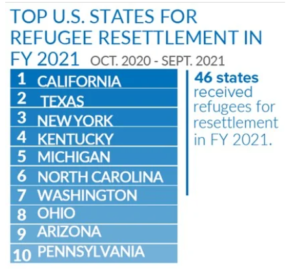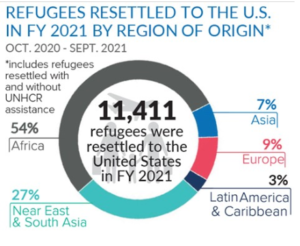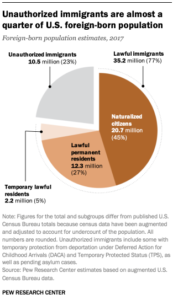လူဝင်မှုကြီးကြပ်ရေး စာမေးပွဲ
လူဝင်မှုကြီးကြပ်ရေး စာမေးပွဲ (pronounced ) luuwainmhukyeekyautrayy hcarmayypwal (say that 10 times fast)
Means – Immigration Quiz in Myanmar (Burmese) ….and with that BEGIN!
Immigration Quiz: (answers at the end of my comments).
1) 1 in 3 businesses in _____are owned by immigrants. Although they make up about 24% of the population, 32.2% of all businesses in the city are owned by immigrants.[1]
a. New York
b. Washington D.C.
c. Dallas
2) U.S. refugee resettlement statistics for 2021 was __________, a 0.49% decline from 2020.[2]
a. 245,600.00
b. 127,315.00
c. 339,179.00
3) US Foreign Born Population as of 2021, ___________, +/- 140,367[3]
a. 17,045,000
b. 45,270,103
c. 62,005,202
4) Internally displaced people worldwide (IDP=people remaining in their own or near their country of origin. _______________.[4]
a. 42 million
b. 103 million
c. 53.2 million
5) ____________ are refugees in the world (as of Mid-2022)[5]
a. 43 million
b. 17 million
c. 32.5 million
6) Most immigrants ________% are in the US legally. [6]
a. 42%
b. 77%
c. 89%
7) The __________________resettlement program is the largest in the world. [7]
a. Canada
b. Turkey
c. USA
In the 3rd Grade I ran away from Puohala Elementary School in Kaneohe, Hawaii because I could not figure out fractions. It created quite the stir in our small community. Ever since then, mathematics has been a tender academic point for me. I have taken every math class twice (up to calculus) since that traumatic time in elementary school. Most of the information has been flushed in the toilet of my mind. Sadly a statistics class seemed an academic bridge too far, but as far as I knew, it was the gate barring access to any doctoral program. Then came DLGP. Thank you Portland Seminary!
Why the quiz some of you might wonder? Well, the seven questions listed above are just the tip of the iceberg for the flood of statistics that I will go through towards my immigration NPO. Lots of statistics, none of them match. I enjoyed Chivers’ book. His voice echoed a comment an old Army instructor said, “numbers lie.” This morning at a men’s bible study, the worship leader commented that “Figures lie, and liars figure.”
“Easy to read”, unlike the academic works of the threshold book, made this subject almost fun to delve into. Chiver’s tidbits at the end of his book held nuggets of wisdom for me as I begin to delve into the large array of numbers that are sharks swimming around the bloody topic of immigration. My top 5 take aways that were new to me.
- Put numbers in context[8] (p 166)
- Check whether the study you’re reporting on is a fair representation of the literature. (p. 166)
- Don’t report forecasts as single numbers. Give the confidence interval and explain it. (p.168)
- Be wary of cherry-picking and random variations. (p.168)
- Give the sample size of the study – and be wary of small samples. (p. 167)
What I really like in having numbers make sense is information graphics. They give me talking points and a visual that helps my audience understand the statistical picture that I am trying to paint. For instance….
Where does your state lie in this chart for US refugee resettlement (or does it?). You may have noted that FLORIDA is not one of the top ten. Why  then is the governor there bussing people up north? Political grandstanding? A play for the presidency?
then is the governor there bussing people up north? Political grandstanding? A play for the presidency?
Yes, immigration is a political foot ball that has been thrown back and forth with no real action by congress for almost 3 decades. Presidents of all flavors have come out for and against immigration, but CONGRESS, has to pull its head out of its (fourth point of contact) if anything can be substantially done.
Where do refugees come from? Why? The spot light is on the southern border but there are numerous categories of  International newcomers. The families from Central and South America are generally asylum seekers. The category of “refugee” is in the infographic. Refugees usually flee their countries of origin and live in a United Nations High Commission of Refugee Camp Refugee (UNHCR) Camp, while their cases are reviewed by the UNHCR for credibility. The average wait/review time in a refugee camp? SEVENTEEN YEARS! This is why the process of Asylum seeking is so attractive to many. As an Asylum Seeker you present your case at the border and BAM you are in (if you don’t have a criminal background or are carrying drugs, guns etc…). The confusion between Refugee, Asylum Seeker, Humanitarian Parolee and the benefits/process for each plagues the immigration dialogue.
International newcomers. The families from Central and South America are generally asylum seekers. The category of “refugee” is in the infographic. Refugees usually flee their countries of origin and live in a United Nations High Commission of Refugee Camp Refugee (UNHCR) Camp, while their cases are reviewed by the UNHCR for credibility. The average wait/review time in a refugee camp? SEVENTEEN YEARS! This is why the process of Asylum seeking is so attractive to many. As an Asylum Seeker you present your case at the border and BAM you are in (if you don’t have a criminal background or are carrying drugs, guns etc…). The confusion between Refugee, Asylum Seeker, Humanitarian Parolee and the benefits/process for each plagues the immigration dialogue.
Now comes the tricky part. UNAUTHORIZED Immigration. I moved to Colorado Springs from Kennedale, Texas. I  loved my red neck church. They had huge hearts for the scripture that were well, the size of TEXAS. But I have to say it took some time and energy for them to come around to “loving the alien amongst us” (Deut 10:18). The jury is still out about unauthorized/illegal immigration. Still the little and medium small sized churches that worked with World Relief (where I was the volunteer coordinator) fed 288,000 individuals during the initial states of Covid (from the USDA Farmers to Family Food Program). This included the LEGAL refugees from African, Burmese, and Spanish Speaking congregations. We rocked. Still the border, and illegal immigration have a strangle hold on the spotlight of the 2024 presidential topic – IMMIGRATION.
loved my red neck church. They had huge hearts for the scripture that were well, the size of TEXAS. But I have to say it took some time and energy for them to come around to “loving the alien amongst us” (Deut 10:18). The jury is still out about unauthorized/illegal immigration. Still the little and medium small sized churches that worked with World Relief (where I was the volunteer coordinator) fed 288,000 individuals during the initial states of Covid (from the USDA Farmers to Family Food Program). This included the LEGAL refugees from African, Burmese, and Spanish Speaking congregations. We rocked. Still the border, and illegal immigration have a strangle hold on the spotlight of the 2024 presidential topic – IMMIGRATION.
Currently, I am teaching 8 Ukrainians, 1 man from Afghanistan, 1 woman from Cuba, 1 woman from Venezuala and finally 1 Burmese gentleman who is getting ready for his US Citizenship Interview. They are my heroes in the “Human Journey.” Go Monomyth! (Side note: Almost all of my students have their Masters or Bachelors degrees).
Oh the answers for the quiz……Answers: 1=c, 2=c, 3=b, 4=c, 5=c, 6=b, 7=c
How did you do?
Shalom…Russ
[1] “‘What Do You Lose If You Don’t Have Anything?’ – Why 1 in 3 Businesses in Dallas Are Owned by Immigrants,” January 25, 2017, https://www.dallasnews.com/news/immigration/2019/08/16/what-do-you-lose-if-you-dont-have-anything-why-1-in-3-businesses-in-dallas-are-owned-by-immigrants/.
[2] “U.S. Refugee Statistics 1960-2023,” Market Research, Macrotrends, accessed January 16, 2023, https://www.macrotrends.net/countries/USA/united-states/refugee-statistics.
[3] “S0502: SELECTED CHARACTERISTICS OF … – Census Bureau Table,” accessed January 16, 2023, https://data.census.gov/table?q=foreign+born&y=2021&tid=ACSST1Y2021.S0502.
[4] United Nations High Commissioner for Refugees, “UNHCR – Refugee Statistics/Refugee Data Finder,” UNHCR, accessed January 16, 2023, https://www.unhcr.org/refugee-statistics/.
[5] Ibid.
[6] No Author, “Selected U.S. Immigration Legislation and Executive Actions, 1790 – 2014,” Pew Research Center’s Hispanic Trends Project (blog), September 28, 2015, https://www.pewresearch.org/hispanic/2015/09/28/selected-u-s-immigration-legislation-and-executive-actions-1790-2014/.
[7] United Nations High Commissioner for Refugees, “Resettlement in the United States,” UNHCR, accessed February 5, 2023, https://www.unhcr.org/en-us/resettlement-in-the-united-states.html.
[8] Tom Chivers and David Chivers, How to Read Numbers: A Guide to Statistics in the News (and Knowing When to Trust Them) (London: Weidenfeld & Nicolson, 2021).
8 responses to “လူဝင်မှုကြီးကြပ်ရေး စာမေးပွဲ”
Leave a Reply
You must be logged in to post a comment.
It is not a popular opinion, but I am certainly sure that the journey of any immigrant is act of a hero especially those that migrated from the underdeveloped countries to the United States of America. And that does not end there; every day that they spend in a foreign land is a journey.
Thanks Noel, coming from immigrant stock myself, I see the value added qualities that come with international newcomers who want to succeed. Many throw themselves into the educational system as a way UP. But the story of immigration is a journey in itself for the U.S.A. I pray that cooler bipartisan heads prevail in the next coming years.
What a great connection you made between our reading and your topic of study. I think that the confusion you shared around language (Refugee, Asylum Seeker, Humanitarian Parolee) is really important and interesting. I am curious: Regarding your area of study, how do you think you could use data to influence those you want to influence with your work? Are there any areas of data you think you need to be careful in sharing?
Hi Jennifer, I don’t think data will change anyone’s mind in regards to immigration. There is a lot of data, but each political party uses just enough to forestall any congressional actions. Thus the executive branch is the only action agency that can have any real effect ( and as a subset the Department of Justice). The Judicial branch is not swayed by statistics (as they only function within the constitutionality of executive actions/congressional acts (if any).
I plan on having UNHCR (world stats) and US stats, sort of a backdrop to demonstrate the need out there, but I hope to gain traction by providing tools to the church that may jumpstart the planning of churches in reaching refugees in their communities.
Sigh (big dreams). Thanks for asking.
By the way – you raised the bar for critical thinking in your post. Some of us felt a little deflated, but I like standing in your shadow (perhaps wisdom shall leak out of you)…thanks for your comments…Shalom…Russ
Hi Russell. Like you, I found myself linking this book to my upcoming research project for my NPO. Unlike you, my statistics regarding Pastoral departures from ministry leadership is not a political hot potato like yours is. With such polarized and political influences using statistics to justify their position, how do you think you will be able to get non-biased and accurate statistics and reasonable communication concerning those numbers? Seems like a tall order!
Hi Scott, Bottom line: Data/Statistics are just the backdrop/background for my NPO. I was asked by the World Relief Church Mobilizer Matt Soren to research WHY churches were not responding to the biblical mandate of Deut 10:18 (orphans, widows AND the alien amongst us – my action verse by the way).
Unfortunately, the stats are used by both political parties to bolster their own efforts. Thus for two decades plus no congressional action has occurred.
The target for my “artifact” is a telephone app that will be made available to World Relief and other resettlement agencies to assist both the refugee and the volunteer support the integration process.
Is it enough? Not sure…but my work continues.
Thanks for your comments…Shalom…Russ
Hi Russell,
Thank you for helping me understand your NPO and our immigration problem better. I appreciate the quiz. Sadly, I don’t think I passed. My heart breaks for those displaced people without home or country. I don’t know if I told you, but I visited a school in Malaysia that teaches school-age undocumented Burmese refugee children. It is very challenging for them to get a basic education even when their families have been in Malaysia for 50 years and they were born there! I was so impressed with their English writing abilities. The students were so delightful and so proud of their learning! I love your heart for undocumented immigrants. It seems you are gathering a lot statistical information. How are you managing all that data?
Hi Jenny, the data will the backdrop that highlights the amount people involved and the need for churches to come around international newcomers. My goal is to provide churches with a jumpstart resource for immigration/integration planning (via the telephone app). I keep hearkening to a church mission or vision without a plan is just a wish. So I want to give churches a leg up.
On data, I will just have to choose some respected data collectors (UNHCR, Department of Homeland Security and perhaps two others) and then keep posted on the DAILY updates. I don’t want to get lost in the numbers but plan on using it as a jumping off place.
Thanks for your comments…Shalom…Russ